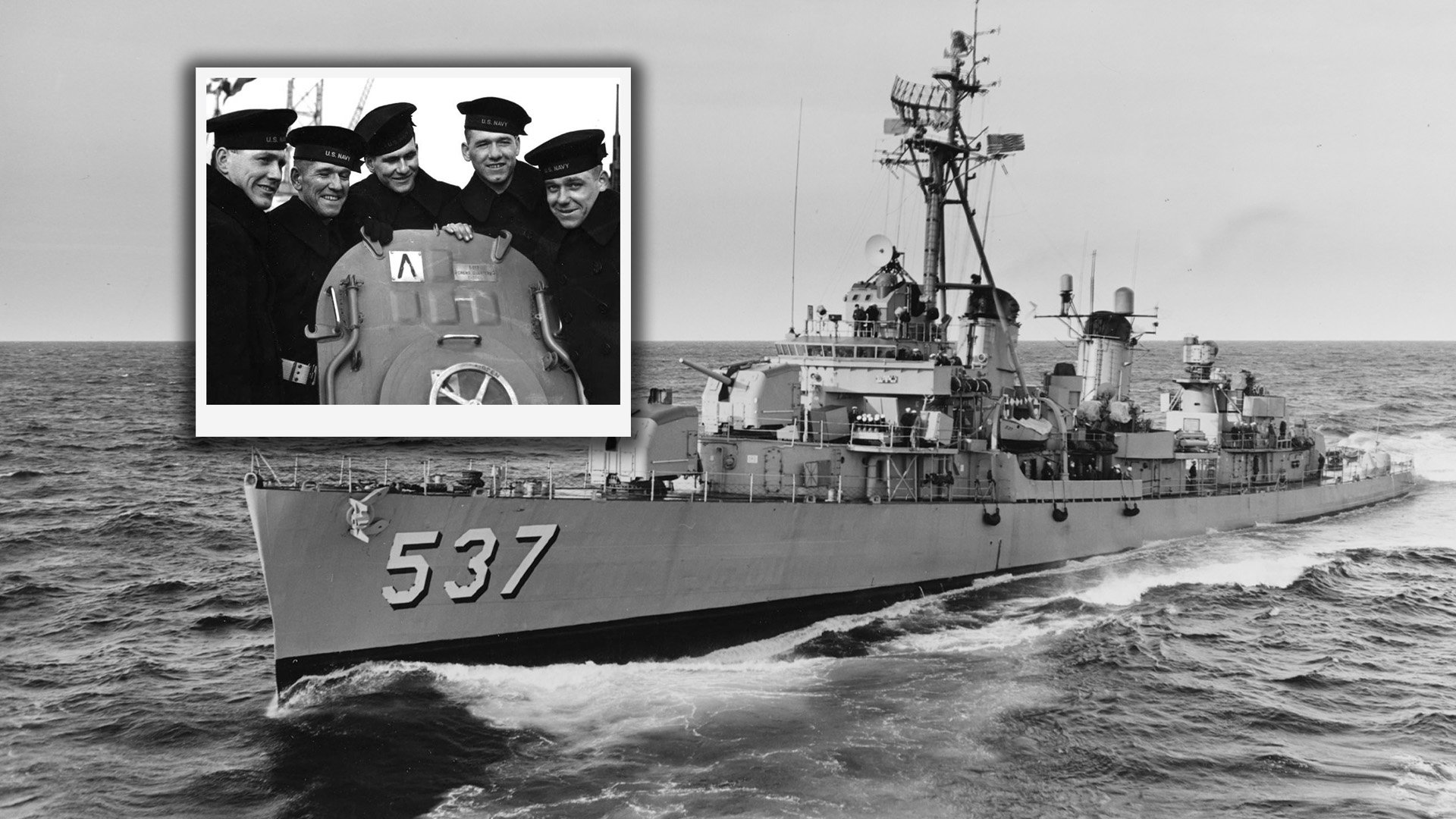
The five Sullivan brothers lost their lives while serving in World War II. The USS The Sullivans (DD-537), a Fletcher-class destroyer, pictured here in 1962, was named in their honor. Wikimedia Commons photos. Composite by Coffee or Die Magazine.
On Nov. 13, 1942, the USS Juneau light cruiser was torpedoed and sunk by a Japanese submarine. Only 10 of the nearly 700 crew members survived the attack. Among the dead were the five Sullivan brothers: George, 27; Francis, or “Frank,” 26; Joseph, nicknamed “Red,” 24; Madison, or “Matt,” 23; and Albert, or “Al,” 20.
The deaths of the Sullivans is the greatest loss ever suffered by any one American family in a single combat incident. The reverberations of the tragedy were so profound that it catalyzed the implementation of the Sole Survivor Policy in 1948.
In addition to the policy, the legacy of the five Sullivan brothers is also enshrined in the US Navy’s USS The Sullivans Fletcher-class destroyer. Commissioned less than a year after the sinking of the Juneau, it was the first American warship named for more than one person.
The Sullivans Fletcher-class destroyer saw action in the Pacific during the latter phases of World War II, then again in Korea. It also played a role in resolving the Cuban Missile Crisis as part of a naval fleet that formed a blockade around Cuba amid negotiations between Washington and the Soviet Union. Retired from service in 1965, the USS The Sullivans is now a floating museum. The ship resides at the Buffalo and Erie County Naval & Military Park in New York.
Indeed, the story of the Sullivans is one worth sharing and preserving. Here’s everything you need to know about the five brothers, their legacy, and the ship named in their honor.
Related: Why the US Navy Annihilated Its Own Battleships With Atomic Bombs
Life Before the Navy
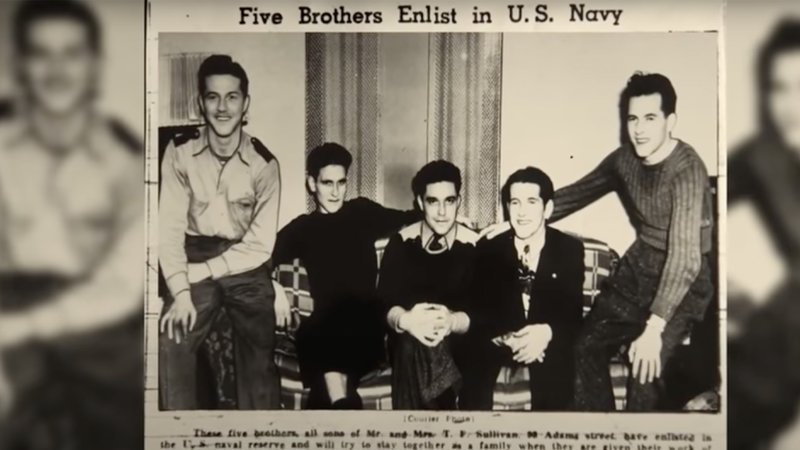
The five Sullivan brothers were motivated to join the military after losing friends during the attacks at Pearl Harbor. Screenshot from YouTube/Naval History & Heritage Command.
The five Sullivan brothers and their sister, Genevieve, grew up in Waterloo, Iowa, during the tumultuous era of the Great Depression. Residents of Waterloo would later recall that the Sullivan parents, Tom, a conductor for the Central Illinois Railroad, and Alletta, a housewife, did not run a strict household. The five boys all left school at 16 and joined the workforce. Not all of the jobs they worked were legitimate. According to World War II magazine, Tom was involved in the moonshine industry and occasionally enlisted his sons to help him pick up and deliver illegal alcohol.
When George and Frank were old enough to join the military, they both decided to become enlisted sailors. The pair served in the peacetime Navy from 1937 to 1941. Then they returned home to Waterloo and joined their brothers working at a local meatpacking plant. According to people who knew them, the Sullivan brothers were a wild bunch. They belonged to the “Harley Club,” a hangout for young men who liked to ride motorcycles, get drunk, and raise hell.
On Dec. 7, 1941, the Japanese attacked Pearl Harbor. As with so many other Americans, the Sullivans’ world was upended by the event and it changed the trajectory of their lives. Soon after the attack, George wrote a letter to the Department of the Navy, requesting that he and his four younger brothers be allowed to enlist and serve together. “We had five buddies killed in Hawaii,” he wrote. “Help us.” The Navy granted George’s request.
Related: Heroism in the Deep: The 1939 Rescue of the USS Squalus
Unprecedented Tragedy at War
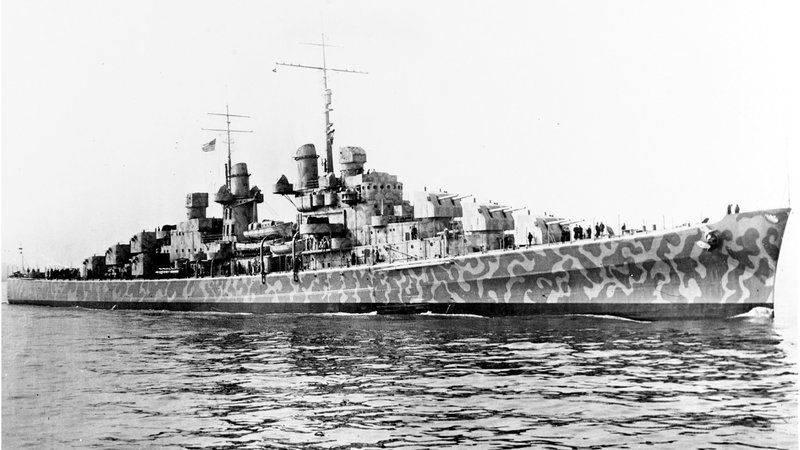
The USS Juneau in New York Harbor on Feb. 11, 1942. Wikimedia Commons photo.
Within a matter of months of George’s letter, he and his brothers became sailors. Since George and Frank had prior military service, they were promoted above their siblings. George became a gunner’s mate second class and Frank a coxswain. The other three were each given the rank of seaman second class. They were all assigned to the newly commissioned USS Juneau, an Atlanta-class light cruiser.
In August 1942, the Juneau embarked for the southwestern Pacific and the Sullivans soon found themselves in the thick of the action. In October, the USS Juneau participated in the Battle of the Santa Cruz Islands, which resulted in heavy American losses, including one aircraft carrier, one destroyer, 81 planes, and many men. All five Sullivan brothers survived the battle.
Several weeks later, on the evening of Nov. 12, just as the Naval Battle of Guadalcanal was getting underway, a torpedo fired by the Japanese destroyer Amatsukaze slammed into the port side of the Juneau.
The explosion immediately destroyed the ship’s steering and weapons systems and killed 19 sailors. The severely damaged Juneau remained afloat, however, and withdrew from the battle. The following morning, it joined a fleet of surviving battleships that limped toward the safer waters of an Allied harbor in the New Hebrides. But before the Juneau could reach its destination, it was intercepted by a Japanese submarine and struck by another torpedo. This time, the torpedo tore the ship apart. It sank in less than a minute.
Four Sullivan brothers — Frank, Red, Matt, and Al — could not escape the vessel. According to survivors’ reports, George, though wounded, managed to get off the Juneau and board a life raft. One of his comrades, Gunner’s Mate 2nd Class Allen Heyn, later claimed that George survived for three or four days. Heyn told a naval investigator that George was experiencing hallucinations and jumped from his life raft into the water to take a bath. “A shark came and grabbed him and that was the end of him,” Heyn said. “I never seen him again.”
However, the official records kept by the Naval History and Heritage Command state that George survived in the lifeboat for only a few hours and died as a result of wounds he sustained in the torpedo attack. In total, the tragedy claimed the lives of nearly 700 American sailors. The majority of them went down with the Juneau, while most of those who managed to board lifeboats died by either exposure, exhaustion, or shark attack.
Related: The USS Gerald Ford Is More Than Just a $13 Billion Boat
What Is the Sole Survivor Policy?
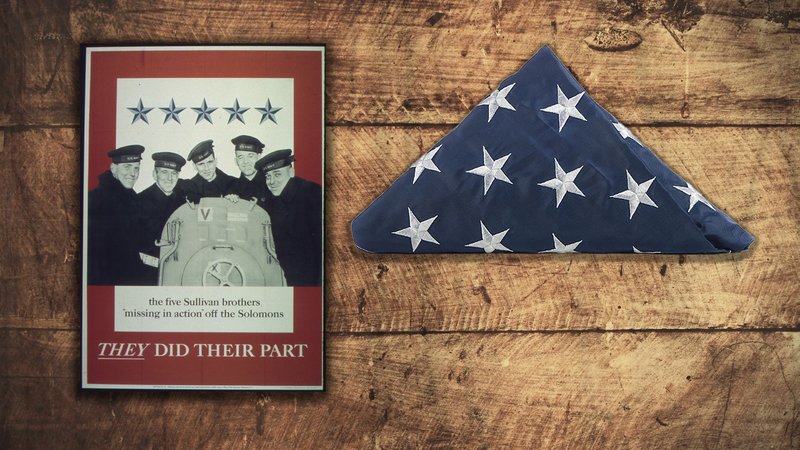
A wartime poster featuring the Sullivan brothers. Wikimedia Commons photo. Composite by Coffee or Die Magazine.
Tom and Alletta Sullivan were not immediately notified that their sons had been killed in action. Eventually, as the people of Waterloo began circulating theories about the fate of the five brothers, Alletta decided to write a letter to the Department of the Navy asking for answers. On Jan. 11, 1943, she received a reply informing her of the terrible news. A letter of condolence from President Franklin Delano Roosevelt arrived in her mailbox soon after.
In the months that followed, Tom and Alletta went on the road to share their sons’ story and encourage Americans to buy war bonds. The attention around the tragedy eventually spurred the US military to take action, and in 1948, the Sole Survivor Policy was enacted. The policy stipulates that if a member of the US Armed Forces dies in the line of service, their siblings and children are either exempted from the draft or pulled from combat duty if they are serving overseas. The exemption also applies to service members whose immediate family member has been declared missing in action or becomes a prisoner of war.
Related: Lenah H. Sutcliffe Higbee: The US Navy's First Living Female Navy Cross Recipient
The USS The Sullivans Battleship & Memorial
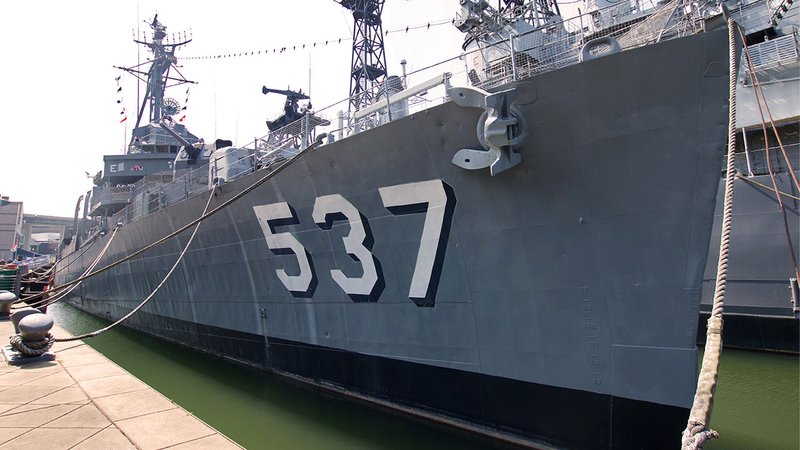
The USS The Sullivans is now a floating museum and resides at the Buffalo and Erie County Naval & Military Park in New York. Photo courtesy of the Buffalo and Erie County Naval & Military Park.
In 1943, the USS The Sullivans battleship was commissioned for military service. The ship, whose official motto is “We Stick Together,” played a prominent role in the Pacific Theater during the latter phases of WWII. Its crew is credited with, among other things, shooting down eight Japanese planes, bombarding Iwo Jima and Okinawa, and rescuing a number of Allied aviators whose aircraft were shot down over the ocean.
During the Korean War, the USS The Sullivans carried out bombardments of strategic enemy supply lines, including railroads and tunnels. All in all, by the time the USS The Sullivans decommissioned in 1965, it had earned 11 battle stars. Today, the USS The Sullivans is registered as a historic landmark and moored at the Buffalo and Erie County Naval & Military Park.
The Buffalo and Erie County Naval & Military Park opened to the public in 1979. As the country’s largest inland Naval & Military Park, it houses four decommissioned naval ships that served in combat between World War II and the Vietnam War. In addition to the USS The Sullivans, which is one of just four surviving Fletcher-class destroyers in the world, the ships are: the USS Little Rock, the last surviving Cleveland-class light cruiser from WWII in existence; the USS Croaker, a Gato-class submarine; and the PTF-17, one of only 20 Nasty-class fast patrol boats ever built.
Ready to catch the first flight to Buffalo so you can see the USS The Sullivans yourself? Not so fast. In the spring of 2022, the USS The Sullivans suffered significant leaks and damage to its engine room. The museum determined that the ship required more than $2 million worth of renovations, which are currently underway. Furthermore, according to the park’s website, the entire park, including museum ships and buildings, are now closed for the season. The park will reopen to the public on March 25, 2023.
Read Next: ‘The Mighty A’ — Reliving History Aboard the USS Alabama

Matt Fratus is a history staff writer for Coffee or Die. He prides himself on uncovering the most fascinating tales of history by sharing them through any means of engaging storytelling. He writes for his micro-blog @LateNightHistory on Instagram, where he shares the story behind the image. He is also the host of the Late Night History podcast. When not writing about history, Matt enjoys volunteering for One More Wave and rooting for Boston sports teams.
BRCC and Bad Moon Print Press team up for an exclusive, limited-edition T-shirt design!
BRCC partners with Team Room Design for an exclusive T-shirt release!
Thirty Seconds Out has partnered with BRCC for an exclusive shirt design invoking the God of Winter.
Lucas O'Hara of Grizzly Forge has teamed up with BRCC for a badass, exclusive Shirt Club T-shirt design featuring his most popular knife and tiomahawk.
Coffee or Die sits down with one of the graphic designers behind Black Rifle Coffee's signature look and vibe.
Biden will award the Medal of Honor to a Vietnam War Army helicopter pilot who risked his life to save a reconnaissance team from almost certain death.
Ever wonder how much Jack Mandaville would f*ck sh*t up if he went back in time? The American Revolution didn't even see him coming.
A nearly 200-year-old West Point time capsule that at first appeared to yield little more than dust contains hidden treasure, the US Military Academy said.












